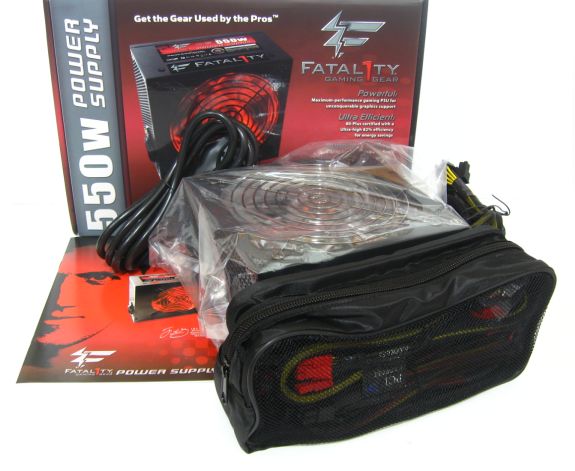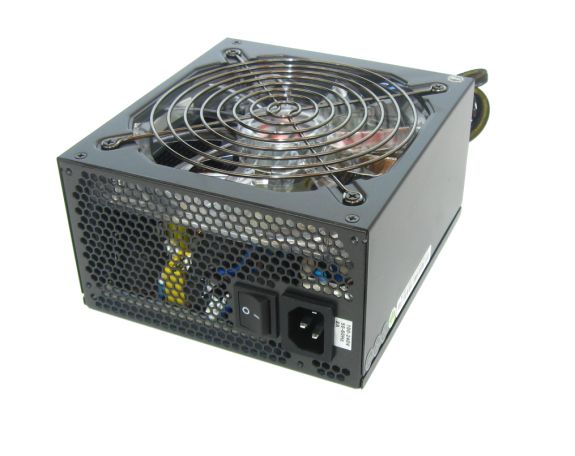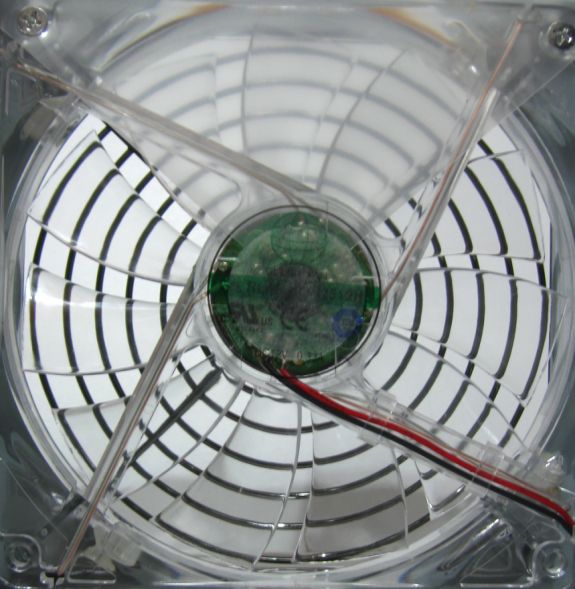550W Roundup: Three PSUs at Different Prices
by Martin Kaffei on October 28, 2010 4:00 PM ESTOCZ Fatal1ty OCZ550FTY
The OCZ Fatal1ty comes with the usual assortment of parts: you get a users manual, a US/UK/Europe power cord (depending on your location), and the necessary mounting screws. In addition, the power supply has cable management ("EZMod Technology for custom cabling"), and the modular cables are placed in a separate bag. The distinctive product features consist of a red LED-fan and active PFC—the latter is not that remarkable, but it's a step up from budget PSUs like the Techsolo. OCZ also makes mention of the 135mm fan and 80 Plus certification. The marketing tells us to "get the Gear used by the Pros", referencing the infamous John "Fatal1ty" Wendel of Quake 3 fame [Ed: has he even done much recently?], and we can only hope the pros use high quality power supplies. OCZ offers a 3-year-warranty with support in their forums.
The varnish is shiny, the ventilation holes are tiny, and when the fan is off you can see almost transparant fan blades and parts of the internal design. The depth of the housing is 16cm, which is okay for a 550W power supply with cable management. There is a large power switch in front of the PSU, but no need to mention this as a feature on the packaging.
| Cables and Connectors | ||
| Fixed/Modular | Main | 24-pin 45cm |
| ATX12V/EPS12V | 4+4-pin 45cm / 4-pin 45cm | |
| PCIe | 6/8-pin 50cm / 6-pin 50cm | |
| Peripheral | 3x PATA 45-75cm / 3x PATA 45-75cm + Floppy 15cm | |
| 3x SATA 45-75cm / 3x SATA 45-75cm | ||
The main cables could be longer than 45cm for use in large cases, but this will work fine otherwise. The 4+4-pin ATX12V and one more 4-pin ATX12V is not bad for a 550W PSU. Six SATA and six Molex connectors are more than enough for common PC configurations, and the floppy connector increases the maxmium cable lenght up to 90cm (but only if you need a mini-4-pin Molex, obviously). Finally, the 6/8-pin and 6-pin PEG connectors make for a reasonable 550W PSU setup.
OCZ continues to use a Globe Fan fan with a double ball bearing, which is partially covered by ducting. The fan needs 0.33 amps and has eleven transparent fan blades.













82 Comments
View All Comments
Phaedrus2129 - Friday, October 29, 2010 - link
Except guess what, PC Power & Cooling was bought by OCZ in 2007, and in 2010 they discontinued the Silencer and Turbocool lines permanently, and replaced them with the "Silencer Mk. II" line. It's the same thing as OCZ's "Z-Series Gold", only cost-down with some last minute jerry-rigged fixes that belie the half-arsed engineering involved, sold for half again as much as the superior OCZ counterparts.Proof that relying on a brand remaining consistently good for all time is a bad idea.
tomoyo - Friday, October 29, 2010 - link
Not sure where you've been, but pc power has been THE posers for a long time now. They got bought out as phaedrus just mentioned by OCZ years back and haven't made a great psu in many years.Beenthere - Friday, October 29, 2010 - link
You need to know which PC Power and Cooling PSUs to purchase and they aren't the pseudo OCZ models.tomoyo - Friday, October 29, 2010 - link
Uh what, an old ass turbocool 860 or 1200 that's massively overpriced, very loud, and overhyped...and also old as hell?I would never recommend PC Power to any modern computer user right now. Any high end Seasonic would blow it out of the water 15 different ways.
Beenthere - Friday, October 29, 2010 - link
Knowledge is power...http://www.hardwaresecrets.com/article/PC-Power-an...
tomoyo - Friday, October 29, 2010 - link
Uh that is exactly a pseudo ocz model.tomoyo - Friday, October 29, 2010 - link
Also see the following review conclusion for why the silencer Mk II disappoints - http://www.hardocp.com/article/2010/08/10/pc_power...mattll - Wednesday, November 3, 2010 - link
This review highlights what I think is the weakness of these PSU reviews.First, there's the issue of silly ripple testing. There is a spec for ripple. If you are inside the spec, that is good enough. There is nothing superior about having less ripple, it is a design choice. Sure, you can measure it on your o-scope, but show me ANY affect on system performance as long as the PSU is inside the spec. There is none. All the rest is an assumption, unsupported by any data, that designing to a smaller ripple somehow indicates better performance. Prove it, in the system outside the PSU. In the absence of such proof, I think such tests are simply means by which reviewers can assign bogus performance metrics to parts which are simply good enough, to satisfy perfectionists who want proof that their choice is superior.
Second, there's the disassembly of the unit and the smug remarks on build quality, with copious amounts of electrical engineering jargon. That jargon exists only to convince the reader the reviewer is knowledgeable.
That's good to know, but it doesn't make the reviewer or the review correct. All the snarky comments about how some unit doesn't meet the reviewers exalted standards for solder quality or cap ESR is puerile, useless crap. Look: can you _measure_ something wrong? If so, comment on that instead. Is the reviewer assuming his exalted standards will play out in the reliability or performance of the product? Prove it!
The measures of output noise, efficiency, ability to carry full load, withstand hot conditions: those are valuable pieces of information. Cost is of course important. Even ripple measurements are fine, as long as you understand that inside the standard there's no difference. Build quality, though, is a subjective measurement very poorly linked to any data on reliability. If reviewers can't be bothered to find anything more substantive on reliability, they should at least have the humility to recognize the limitations of build quality observations and not be too dogmatic about it.
With regard to this PCPC review, the reviewer seemed to fixate on a production mod capacitor jumpered rather than designed into the circuit board. Boohoo, cry me a river. Did it make any performance difference? If the reviewer hadn't opened the case, was there any actual functional difference? Is there any data, any data at all to indicate such a jumpered capacitor would be any less reliable? Chances are, many customers would actually get the next rev circuit board with the cap in place. At any rate, the generous warranty meant the manufacturer was putting its money behind it. Likely each jumpered unit was subjected to more rigorous testing because of the custom work.
In short, the whole review obsessed on silly, subjective details while acknowledging the performance was fine. If they thought the unit was overpriced relative to performance, that would be fine, but that wasn't their complaint. The reviewer was probably biased because of his previous experiences with PCPC, but that's the danger of subjective metrics.
Disclaimer: I don't work in the PSU industry, although I have a degree in that area. I don't own or have any vested interest in any of those products.
Calin - Friday, October 29, 2010 - link
Bought an 350W, 12 cm fan Seasonic power supply for some $100, in the times when the Athlon 4600+ (dual cores) were the mainstream from AMD - maybe three years ago, maybe more.Very happy I've been with it
sprockkets - Friday, October 29, 2010 - link
No mention of the weight of the power supplies? That's usually a dead giveaway.